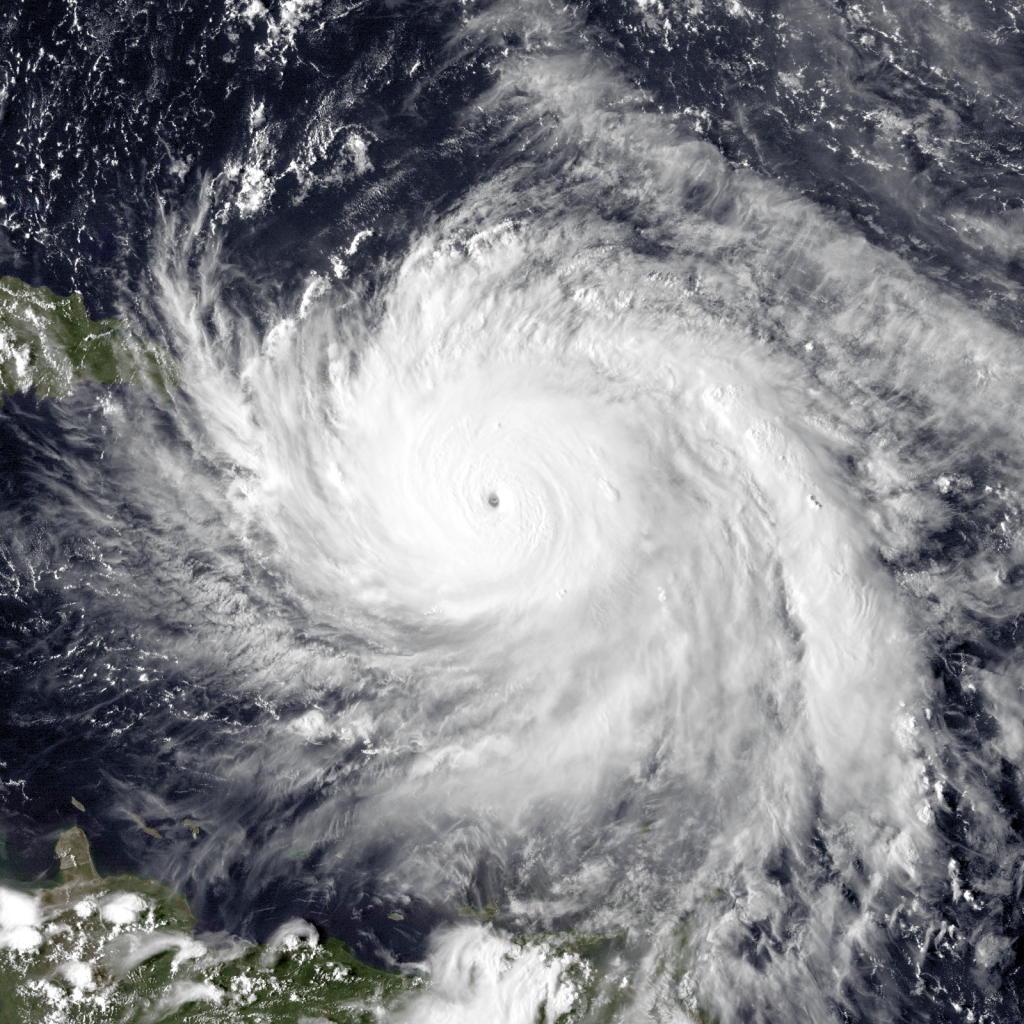
Hurricane Maria near peak intensity, moving north towards Puerto Rico, on September 19, 2017. New research shows hurricanes or other strong storms can produce vibrations in the nearby ocean floor as strong as a magnitude 3.5 earthquake.
Credit: Naval Research Laboratory/NOAA.
AGU press contact:
Lauren Lipuma, +1 (202) 777-7396, [email protected]
Contact information for the researchers:
Wenyuan Fan, Florida State University, +1 (850) 644-6265, [email protected]
WASHINGTON—Researchers have discovered a new geophysical phenomenon where a hurricane or other strong storm can produce vibrations in the nearby ocean floor as strong as a magnitude 3.5 earthquake.
“We’re calling them ‘stormquakes,’” said Wenyuan Fan, an assistant professor of Earth, Ocean and Atmospheric Science at Florida State University and lead author of a new study detailing the findings in AGU’s journal Geophysical Research Letters. “During a storm season, hurricanes or nor’easters transfer energy into the ocean as strong ocean waves, and the waves interact with the solid earth producing intense seismic source activity.”
Fan and his colleagues analyzed nearly a decade of seismic and oceanographic records from September 2006 to February 2019 and found a connection between strong storms and intense seismic activity – vibrations in Earth’s crust – near the edge of continental shelves or ocean banks.
Specifically, they found evidence of more than 10,000 stormquakes occurring from 2006 to 2019 offshore of New England, Florida and the Gulf of Mexico in the United States, as well as offshore of Nova Scotia, Newfoundland and British Columbia in Canada.
“We can have seismic sources in the ocean just like earthquakes within the crust,” Fan said. “The exciting part is seismic sources caused by hurricanes can last from hours to days.”
In the new study, Fan and his colleagues developed a new method to detect and locate seismic events and determine whether such events are stormquakes. They found 2009’s Hurricane Bill, which made landfall on Newfoundland on August 22, produced numerous stormquakes off the coasts of New England and Nova Scotia.
Similarly, Hurricane Ike in 2008 caused stormquake activity in the Gulf of Mexico and Hurricane Irene in 2011 did the same near Little Bahama Bank off the coast of Florida.
Not all hurricanes cause stormquakes, but when they do, the stormquakes seem to be concentrated in certain hotspots, according to the study’s authors. They detected no evidence of stormquakes off the coast of Mexico or along the U.S. East Coast from New Jersey to Georgia.
Even Hurricane Sandy, one of the costliest storms on record in the United States, did not spur stormquakes, according to the researchers. This suggests stormquakes are strongly influenced by the local oceanographic features and seafloor topography, Fan said.
“We have lots of unknowns,” Fan said. “We weren’t even aware of the existence of the natural phenomenon. It really highlights the richness of the seismic wave field and suggests we are reaching a new level of understanding of seismic waves.”
###
Founded in 1919, AGU is a not-for-profit scientific society dedicated to advancing Earth and space science for the benefit of humanity. We support 60,000 members, who reside in 135 countries, as well as our broader community, through high-quality scholarly publications, dynamic meetings, our dedication to science policy and science communications, and our commitment to building a diverse and inclusive workforce, as well as many other innovative programs. AGU is home to the award-winning news publication Eos, the Thriving Earth Exchange, where scientists and community leaders work together to tackle local issues, and a headquarters building that represents Washington, D.C.’s first net zero energy commercial renovation. We are celebrating our Centennial in 2019. #AGU100
Notes for Journalists
This paper is freely available through November 15. Journalists and public information officers (PIOs) can download a PDF copy of the article by clicking on this link:
https://agupubs.onlinelibrary.wiley.com/doi/pdf/10.1029/2019GL084217
Neither this paper nor this press release is under embargo.
Paper Title
“Stormquakes”
Authors
Wenyuan Fan: Department of Earth, Ocean and Atmospheric Science, Florida State University, Tallahassee, Florida, U.S.A.;
Jeffrey J. McGuire: U.S. Geological Survey, Earthquake Science Center, Menlo Park, California, U.S.A., and Department of Geology and Geophysics, Woods Hole Oceanographic Institution, Woods Hole, Massachusetts, U.S.A.;
Catherine D. de Groot-Hedlin, Michael A.H. Hedlin, Julia W. Fielder: Scripps Institution of Oceanography, UC San Diego, La Jolla, California, U.S.A.;
Sloan Coats: Department of Geology and Geophysics, Woods Hole Oceanographic Institution, Woods Hole, Massachusetts, U.S.A.





修改评论